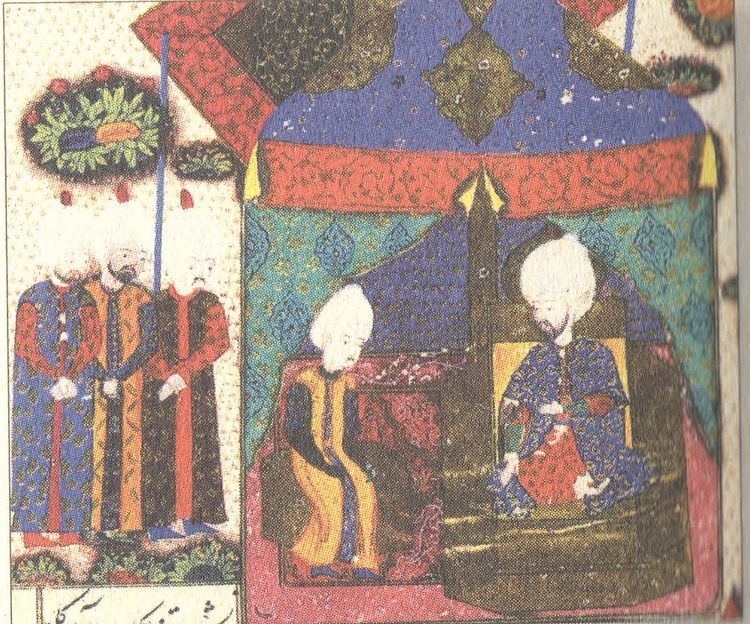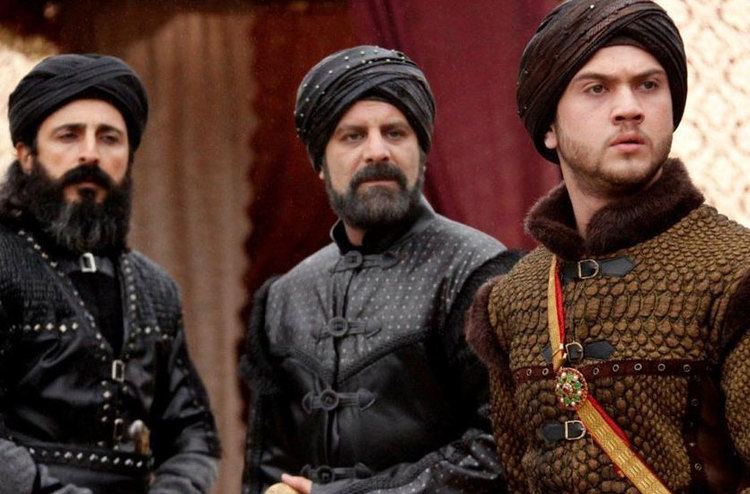Spouse Fatma Hatun Name Sehzade Bayezid | House House of Osman | |
 | ||
Died September 25, 1561 (aged 35-36)Safavid Persia Issue Sehzade OrhanSehzade OsmanSehzade AbdullahSehzade MahmudSehzade MuradMihrumah SultanHatice SultanAyse SultanHanzade Sultan Father | ||
Princess Mary Tudor+Sehzade Bayezid || Sehzade Bayezid's Death
Şehzade Bayezid (1525 – September 25, 1561) was an Ottoman prince (Turkish: şehzade) as son of Sultan Suleiman I (also known as the Suleiman the Lawgiver or the Suleiman the Magnificent), 10th Ottoman Sultan, and his legal wife Hürrem Sultan. He unsuccessfully revolted to win the throne of the Ottoman Empire. After the death of three of Suleiman's sons, only Bayezid and Selim were alive. By the course of the 1550s, when Suleiman was already in his 60s, a protracted competition for the throne between Bayezid and Selim was evident. Angered by Bayezid's disobedience stemming from around the same years, Bayezid had fallen in disfavour with his father as opposed to his brother Selim (who would eventually succeed as Selim II). After a staged rebellion, which was suppressed in 1559 by Selim (who was further aided by Suleiman and Sokollu Mehmet Pasha) he fled to the neighbouring Safavid Empire, where he was wholeheartedly and lavishly received by Tahmasp I. However, in 1561, upon continuous insistment of Suleiman throughout the entire period of his exile, and by the means of several large payments, Tahmasp allowed Bayezid to be executed by an Ottoman executioner.
Contents
- Princess Mary TudorSehzade Bayezid Sehzade Bayezids Death
- The Life Rebellion And Death Of Sehzade Bayezid
- Background
- Rebellion
- After the rebellion
- Family
- In popular culture
- References

The Life, Rebellion And Death Of Sehzade Bayezid
Background

Bayezid born in Constantinople (Istanbul), 1525 during the reign of his father, Suleiman the Magnificent. His mother was Hürrem, orthodox priest’s daughter, who was sultan’s concubine in that time. Bayezid had three elder full-brother, Mehmed (born 1521), Abdullah (born 1522), and Selim (born 28 May 1524), one elder full-sister Mihrimah (born 21 March 1522), and one younger full-brothers, Cihangir (born 9 December 1531). He also had half-siblings: Mustafa son of Mahidevran, Murad, Mahmud, and Raziye. In 1533 or 1534,breaking a two-century-old tradition,his father freed and legally wed his mother.

As a court rule, şehzades were appointed to govern a province in order to gain administrative experience. Bayezid became a governor of an Anatolian province (Turkish: sanjak). However, during his father's 12th campaign to Nakhchivan, part of modern Azerbaijan, in 1553, he was assigned to rule in Edirne, the Ottoman capital in European part, to control Rumelia, European territories of the empire, in the absence of his father. During the campaign, Şehzade Mustafa, was executed upon Sultan's order. The news of execution caused unrest in all parts of the empire and an impostor, claiming to be the executed Mustafa, rebelled against Suleiman in Rumelia. Although the rebellion was subdued by a vizier, Suleiman suspected that his son Bayezid was deliberately slow to react.
Rebellion

Suleiman had five sons. His second son Mehmed had died a decade earlier in 1543. After the execution of Mustafa, who had been the most potential heir of the throne in 1553 and Cihangir's death, the youngest brother, who suffered from poor health, only two princes were left to be the potential claimant to throne: Selim, the future Selim II, and Bayezid. Selim was the governor of Manisa and Bayezid was the governor of Kütahya, two cities at almost equal distance from Constantinople, the capital.

Suleiman was in his 60s, and the competition between the two brothers over the throne was evident. Suleiman scolded his sons and decided to change their places of duty. Selim was assigned to rule in Konya and Bayezid in Amasya, both provinces being this time further from the Constantinople but still equidistant. Selim was quick to obey and promptly moved to Konya. But to the dismay of his father, Bayezid obeyed only after much hesitation, because Amasya was the sanjak of his executed brother Mustafa, he took it as a humiliation. Angered, Suleiman accused Bayezid of being a rebel and supported his elder son Selim against the disobedient Bayezid. Selim, in collaboration with Sokollu Mehmet Pasha, the future grand vizier, defeated his brother in a battle near Konya on May 31, 1559.
After the rebellion
Bayezid returned to Amasya and escaped to Safavid Empire with his sons and a small army. According to journalist and historian researcher Murat Bardakçı, Sokullu Mehmet Pasha sent an army after Bayezid, which was defeated by Bayezıd's forces. In the autumn of 1559, he reached the Safavid town of Yerevan, where he was received with great respect by its governor. Some time later, he reached Tabriz, where he was welcomed by Shah Tahmasp I. Although Tahmasp I initially wholeheartedly and lavishly welcomed Bayezid, including giving magnificent parties in his honour, he later jailed him on the request of Sultan Suleiman. Both Suleiman and Selim sent envoys to Persia to persuade the shah to execute Bayezid. For the coming one and half year in fact, embassies would continue to travel between Istanbul and Qazvin. On 16 July, what would be the last of the Ottoman embassies would arrive, whose formal task, like the previous embassies, was to try return Bayezid to Istanbul. As stated by Prof. Colin P. Mitchell, this included Khusrau Pasha (the governor of Van), Sinan Pasha, Ali Aqa Chavush Bashi, and a retinue of two hundred officials. In the letter that was given with the embassy, Suleiman also declared his readiness to reconfirm the Treaty of Amasya (1555) and to begin a new era of Ottoman–Safavid relations. Suleiman, throughout the embassies, also gave Tahmasp numerous gifts. He also agreed with Tahmasp's demand to pay him for handing Bayezid over (400,000 gold coins were given). Finally, on September 25, 1561, Bayezid and his four sons were handed over by Tahmasp and executed in the environs of the Safavid capital Qazvin by the Ottoman executioner, Ali Aqa Chavush Bashi, through the way of garrotting.
Family
Bayezid had five sons:
Bayezid had four daughters:
In popular culture
In the 2011–2014 TV series Muhteşem Yüzyıl he is portrayed by Aras Bulut İynemli.
